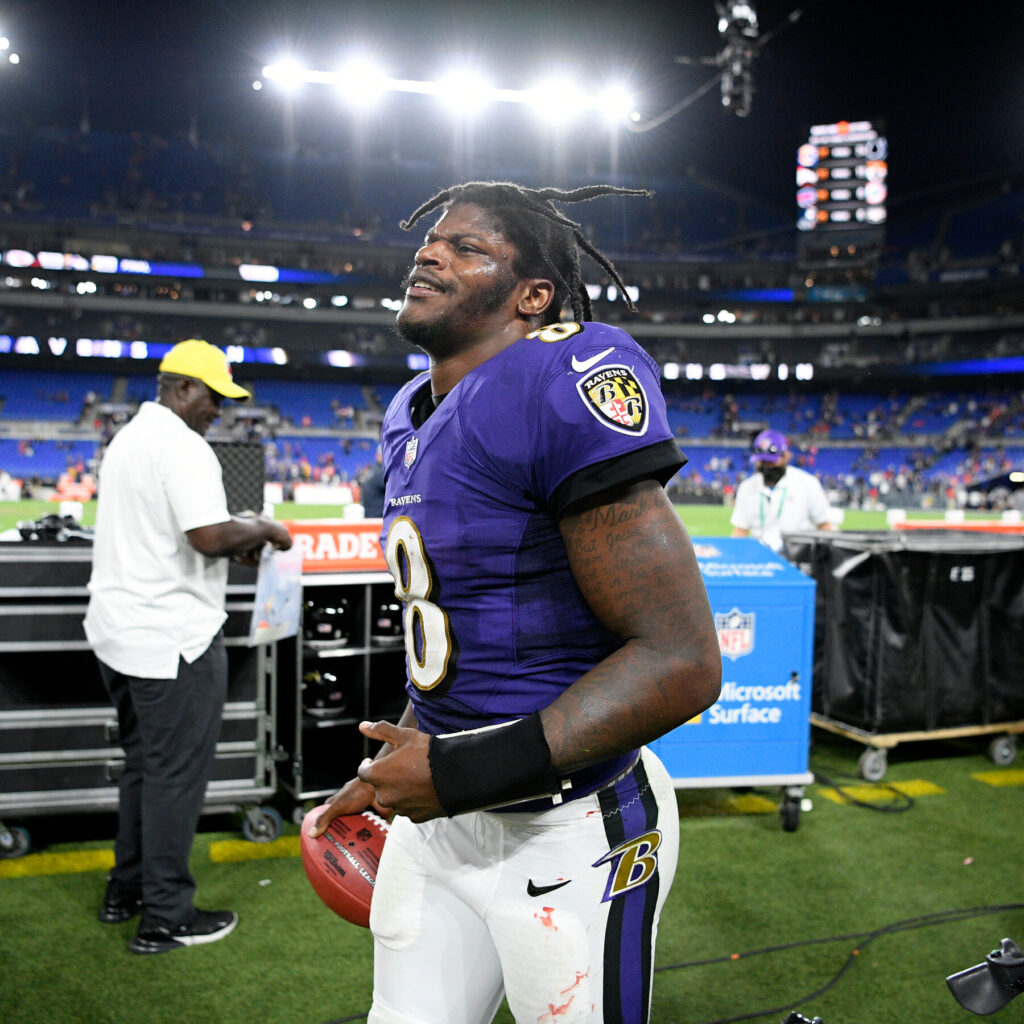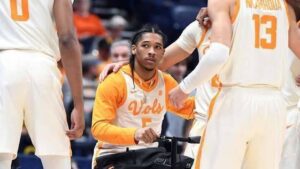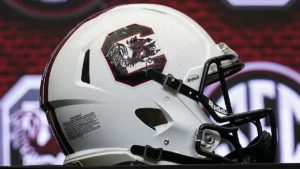
Lamar Jackson’s trade with the Baltimore Ravens is one of the greatest draft deals ever.
The 2018 NFL Draft was filled with storylines—quarterback speculation, surprises, and shifting strategies. But amid the chaos and late-night tension of Day 1, the Baltimore Ravens pulled off one of the most consequential and franchise-defining moves in modern NFL history. With the final pick of the first round, Baltimore selected Lamar Jackson, a Heisman-winning dual-threat quarterback from Louisville. What made the moment historic wasn’t just who they picked—but how they got there.
To land Jackson, the Ravens made a last-minute trade with the Philadelphia Eagles, surrendering their 52nd and 125th picks in that draft, plus a 2019 second-rounder, to jump back into the first round at No. 32. The trade flew somewhat under the radar at the time—until Lamar Jackson transformed from a “project QB” into the face of the franchise and the 2019 NFL MVP.
Now, in hindsight, that draft-day gamble isn’t just seen as wise—it’s becoming recognized as one of the greatest draft trades in NFL history.
Part I: The Trade Details
Let’s break it down.
The Trade:
- Ravens received: Pick No. 32 overall (used to draft Lamar Jackson)
- Eagles received: Pick No. 52 (second round), Pick No. 125 (fourth round), and a 2019 second-round pick
Baltimore had already selected tight end Hayden Hurst earlier in the first round at No. 25. But rather than ending the night there, GM Ozzie Newsome—making the final first-round pick of his Hall of Fame executive career—decided to go all-in on a player who could redefine the franchise.
It wasn’t just a shrewd pick—it was visionary. Especially considering Jackson was the fifth quarterback taken in the first round behind Baker Mayfield, Sam Darnold, Josh Allen, and Josh Rosen.
Part II: Betting on Lamar—When Few Believed
When Jackson entered the draft, he was met with skepticism. Questions swirled about his throwing mechanics, accuracy, and whether he could play quarterback at the next level. Some analysts even suggested he should switch to wide receiver—a suggestion Jackson famously dismissed with confidence: “I’m a quarterback.”
Baltimore believed in him. They didn’t just draft a quarterback—they drafted a culture-shifter. What set the Ravens apart was their willingness to build around his strengths, not force him into a mold he didn’t fit. They tailored their offense to suit his unique combination of speed, elusiveness, and playmaking instinct.
Part III: The Breakout—2019 MVP Season
After a brief stint behind Joe Flacco, Jackson took over as starter midway through the 2018 season. In 2019, he exploded. His numbers were video game-like:
- Passing: 3,127 yards, 36 TDs, 6 INTs
- Rushing: 1,206 yards, 7 TDs
- Team Record: 14-2
Lamar Jackson became the youngest quarterback in NFL history to win MVP unanimously. He led the league in touchdown passes and broke Michael Vick’s single-season rushing record for a QB. The Ravens offense became must-see TV, blending speed, creativity, and sheer unpredictability.
That 2019 season was not just a breakout—it was a blueprint for how a modern NFL offense could thrive around a dual-threat QB.
Part IV: Rewriting Baltimore’s Identity
Before Jackson, the Ravens had been a team known for defense, field position, and conservative offense. Think Ray Lewis, Ed Reed, and gritty wins. With Jackson under center, they evolved into one of the NFL’s most dynamic offensive teams.
Greg Roman’s playbook unlocked Jackson’s talents, and Baltimore built one of the league’s top rushing attacks behind him. More than that, Jackson brought energy, charisma, and swagger that galvanized a new generation of fans.
From 2018 to 2023, Baltimore made five playoff appearances. While the postseason success has been inconsistent, there’s no denying Jackson elevated the franchise’s ceiling. Every season with him gives Baltimore a real shot at a Super Bowl.
Part V: Measuring the Value—What the Ravens Gave Up vs. Got
To evaluate how great a draft trade is, you compare what a team gave up vs. what they got.
Here’s what Philadelphia turned those picks into:
- Pick 52: Dallas Goedert, tight end – A solid, top-10 tight end who’s contributed but isn’t a game-changer.
- Pick 125: Avonte Maddox, cornerback – A valuable depth player and nickel CB.
- 2019 second-rounder: Traded again by the Eagles, eventually used in a package that landed them offensive lineman Andre Dillard, who didn’t become a consistent starter.
All solid NFL players, but none of them shifted a franchise’s destiny.
Baltimore, on the other hand, landed a franchise QB who became an MVP, made multiple Pro Bowls, and helped keep the team in playoff contention for the better part of a decade.
If you’re grading this as a transaction? The Ravens pulled off a franchise-altering heist.
Part VI: Impact on the QB Market
Another layer to this story: Lamar Jackson’s presence in the draft altered how teams view the quarterback position. His success opened the door for dual-threat prospects like Kyler Murray, Jalen Hurts, Anthony Richardson, and others to be evaluated as true QBs rather than “athletes.”
More teams began to understand that it’s not about fitting a mold—it’s about maximizing your weapon.
Baltimore didn’t just steal Jackson at No. 32—they helped change the narrative around the modern NFL quarterback.
Part VII: The 2023 Contract Saga—and Resolution
Fast forward to 2023. Lamar Jackson’s contract negotiations made headlines for months. The Ravens applied the non-exclusive franchise tag, and speculation of a trade or departure ran wild. Jackson wanted a long-term deal that reflected his value as a top-tier quarterback—and he eventually got it:
- 5 years, $260 million ($185 million guaranteed)
It was the largest contract in franchise history, making Jackson one of the highest-paid players in the NFL. The Ravens’ decision to pay him reaffirmed the importance of that 2018 draft night trade. They didn’t just get lucky—they bet correctly.
Part VIII: Legacy and Longevity
The most remarkable part? Jackson is still just entering his prime. At only 28 years old heading into the 2025 season, he has plenty of elite football left. Barring injury, the Ravens can count on at least 4–5 more years of top-level quarterback play—and likely more playoff appearances.
And if Lamar Jackson wins a Super Bowl, this trade won’t just be among the greatest—it may become the single most impactful first-round trade in NFL history.
Part IX: Comparisons with Other Great Draft Trades
Let’s put this in perspective.
Some of the most famous NFL draft trades include:
- Cowboys trading Herschel Walker (1989): A haul that built a dynasty.
- Chiefs trading up for Patrick Mahomes (2017): Another franchise-altering QB move.
- 49ers trading up for Jerry Rice (1985): Transformed the offense.
- Giants trading for Eli Manning (2004): Led to two Super Bowl wins.
Jackson’s trade belongs in this tier. Even without a Super Bowl (yet), his MVP season, consistent elite play, and role in reshaping Baltimore’s identity elevate this trade into historic territory.
Greatness Measured in Impact
Lamar Jackson’s draft night trade wasn’t just a footnote. It was a fork-in-the-road moment that defined the next decade of Ravens football. It took guts. It took vision. And it took belief in a player others doubted.
Baltimore didn’t just draft a quarterback—they acquired a cornerstone, a playmaker, and a symbol of innovation. The ripple effects of that 2018 trade have touched nearly every part of the franchise, from ticket sales to national TV exposure to playoff relevance.
In a league where finding a franchise quarterback is the holy grail, the Ravens stole one at pick No. 32. And in doing so, they didn’t just win a draft—they won an era.





